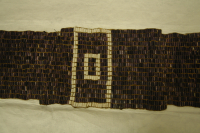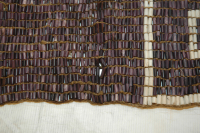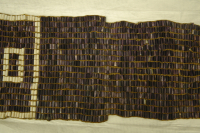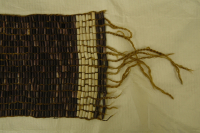wampum belt
wampum belt
wampum belt

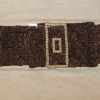
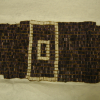
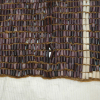
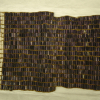
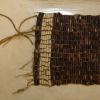
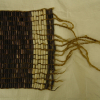
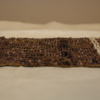
Wampum belt, with a design of three rectangles, each containing a smaller rectangle inside. Iroquois or Anishinaabe. Purchased by the British Museum from Mrs. D. K.Oldman in 1949, whose husband W. O. Oldman acquired the belt from Worden Hall, Lancashire, in the 1940s.
Anishinaabeg or Hodenosaunee:
Read More About This Relative
Made with two-ply "S" twist vegetable fibre thread and purple and white wampum beads.
The belt has a middle section slightly wider than the ends. It is 370 beads long, with 17 warps on both ends and 19 in the middle. There are 16 rows of beads wide at the ends and and 18 wide in the middle. The larger middle section is 64 beads long.
The design, done in white wampum upon a ground of purple wampum, is composed of three rectangles, each of which contains a smaller rectangle. As well, two white bands appear at either end of the belt. The tops and bottoms of the rectangles run along the edges of the belt.
BM and HL wondered if each rectangle might represent a territory or village - the inner rectangle would be village and the outer would be the territory. AC noted that a rectangle or square is a shape typically used to represent a European house or fort and the centre rectangle could be the footprint of a longhouse. BM also asked if it could be a war belt.
Provenance
This belt was purchased by the British Museum from Mrs D K Oldman in 1949. Her husband, W O Oldman, acquired the belt from Worden Hall, Lancashire, in the 1940s. The British Museum's catalogue information explains that while art historian Ralph T. Coe has written that this belt may have been collected by Sir John Werden, 1670-1716, who was secretary to James Stuart, Duke of York, this association is probably erroneous and highly speculative. Additional research done by the British Museum's J C King suggests the belt may be Maliseet or another Algonquian people, from the 18th century.
National Gallery of Canada, Ottawa. Art of this Land. 01 April 2005. British Museum, North America Gallery: First Peoples, First Contacts. June 1999.
Ralph T. Coe, 'Sacred Circles', London, 1976. John Cribb, ed. 'Money. From Cowrie Shells to Credit Cards', London: BMP, 1986, p.30.
About This GRASAC Record
Unknown Anishinaabeg/Haudenosaunee artist, wampum belt. Currently in the British Museum, Am1949,22.119. Item photographed and described as part of a GRASAC research trip December 2007; GRASAC item id 24461.
This record was created as part of a Great Lakes Research Alliance for the Study of Aboriginal Arts and Cultures (GRASAC) research trip to the Pitt Rivers Museum and British Museum, December 8-22 2007, funded by a grant from the International Opportunities fund of the Social Sciences and Humanities Research Council (SSHRC).
Researchers present: Heidi Bohaker (HB), John Borrows (JB), Lindsay Borrows (LB), Alan Corbiere (AC), Henrietta Lidchi (HL), Stacey Loyer (SL), Janis Monture (JM), Bruce Morito (BM), Ruth Phillips (RP), Anne De Stecher (AS), Cory Willmott (CW).
 Knowledge Sharing Platform
Knowledge Sharing Platform


